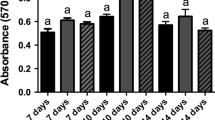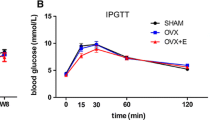Abstract
Ovariectomy (OVX)-induced bone loss has been linked to increased bone turnover and higher bone matrix collagen degradation as the result of osteoclast activation. However, the role of degraded collagen matrix in the fate of resident bone-forming cells is unclear. In this report, we show that OVX-induced bone loss is associated with profound decreases in collagen 1 and Sirt1. This was accompanied by increases in expression and activity of the senescence marker collagenase and expression of p16/p21 in bone. Feeding a diet supplemented with blueberries (BB) to pre-pubertal rats throughout development or only prior to puberty [postnatal day 21 (PND21) to PND34] prevents OVX-induced effects on expression of these molecules at PND68. In order to provide more evidence and gain a better understanding on the association between bone collagen matrix and resident bone cell fate, in vitro studies on the cellular senescence pathway using primary calvarial cells and three cell lines (ST2 cells, OB6, and MLO-Y4) were conducted. We found that senescence was inhibited by collagen in a dose–response manner. Treatment of cells with serum from OVX rats accelerated osteoblastic cell senescence pathways, but serum from BB-fed OVX rats had no effect. In the presence of low collagen or treatment with OVX rat serum, ST2 cells exhibited higher potential to differentiate into adipocytes. Finally, we demonstrated that bone cell senescence is associated with decreased Sirt1 expression and activated p53, p16, and p21. These results suggest that (1) a significant prevention of OVX-induced bone cell senescence from adult rats can occur after only 14 days consumption of a BB-containing diet immediately prior to puberty, and (2) the molecular mechanisms underlying this effect involves, at least in part, prevention of collagen degradation.






Similar content being viewed by others
References
Bailey AJ, Knott L (1999) Molecular changes in bone collagen in osteoporosis and osteoarthritis in the elderly. Exp Gerontol 34:337–351
Campisi J, d'Adda di Fagagna F (2007) Cellular senescence: when bad things happen to good cells. Nat Rev Mol Cell Biol 8:729–740
Chen JR, Haley RL, Hidestrand M, Shankar K, Liu X, Lumpkin CK, Simpson PM, Badger TM, Ronis MJ (2006) Estradiol protects against ethanol-induced bone loss by inhibiting up-regulation of receptor activator of nuclear factor-kappaB ligand in osteoblasts. J Pharmacol Exp Ther 319:1182–1190
Chen JR, Lazarenko OP, Haley RL, Blackburn ML, Badger TM, Ronis MJ (2009) Ethanol impairs estrogen receptor signaling resulting in accelerated activation of senescence pathways while estradiol attenuates the effects of ethanol in osteoblasts. J Bone Miner Res 24:221–230
Chen JR, Lazarenko OP, Wu X, Kang J, Blackburn ML, Shankar K, Badger TM, Ronis MJ (2010) Dietary-induced serum phenolic acids promote bone growth via p38 MAPK/β-catenin canonical Wnt signaling. J Bone Miner Res 25:2399–2411
Choi HR, Cho KA, Kang HT, Lee JB, Kaeberlein M, Suh Y, Chung IK, Park SC (2011) Restoration of senescent human diploid fibroblasts by modulation of the extracellular matrix. Aging Cell 10:148–157
Dimri GP, Lee X, Basile G, Acosta M, Scott G, Roskelley C, Medrano EE, Linskens M, Rubelj I, Pereira-Smith O, Peacocke M, Campisi J (1995) A biomarker that identifies senescent human cells in culture and in aging skin in vivo. Proc Natl Acad Sci USA 92:9363–9367
Ecklund K, Vajapeyam S, Feldman HA, Buzney CD, Mulkern RV, Kleinman PK, Rosen CJ, Gordon CM (2010) Bone marrow changes in adolescent girls with anorexia nervosa. J Bone Miner Res 25:298–304
Engler AJ, Sen S, Sweeney HL, Discher DE (2006) Matrix elasticity directs stem cell lineage specification. Cell 126:677–689
Harley CB, Futcher AB, Greider CW (1990) Telomeres shorten during ageing of human fibroblasts. Nature 345:458–460
Hu Y, Liu J, Wang J, Liu Q (2011) The controversial links among calorie restriction, SIRT1, and resveratrol. Free Radic Biol Med 51:250–256
Katayama Y, Battista M, Kao WM, Hidalgo A, Peired AJ, Thomas SA, Frenette PS (2006) Signals from the sympathetic nervous system regulate hematopoietic stem cell egress from bone marrow. Cell 124:407–421
Kilian KA, Bugarija B, Lahn BT, Mrksich M (2010) Geometric cues for directing the differentiation of mesenchymal stem cells. Proc Natl Acad Sci USA 107:4872–4877
Kousteni S, Chen JR, Bellido T, Han L, Ali AA, O'Brien CA, Plotkin L, Fu Q, Mancino AT, Wen Y, Vertino AM, Powers CC, Stewart SA, Ebert R, Parfitt AM, Weinstein RS, Jilka RL, Manolagas SC (2002) Reversal of bone loss in mice by nongenotropic signaling of sex steroids. Science 298:843–846
Krizhanovsky V, Yon M, Dickins RA, Hearn S, Simon J, Miething C, Yee H, Zender L, Lowe SW (2008) Senescence of activated stellate cells limits liver fibrosis. Cell 134:657–667
Li Y, Tollefsbol TO (2011) p16(INK4a) suppression by glucose restriction contributes to human cellular lifespan extension through SIRT1-mediated epigenetic and genetic mechanisms. PLoS One 6:e17421
Manolagas SC (2010) From estrogen-centric to aging and oxidative stress: a revised perspective of the pathogenesis of osteoporosis. Endocr Rev 31:266–300
McBeath R, Pirone DM, Nelson CM, Bhadriraju K, Chen CS (2004) Cell shape, cytoskeleta tension, and RhoA regulate stem cell lineage commitment. Dev Cell 6:483–495
Nakano-Kurimoto R, Ikeda K, Uraoka M, Nakagawa Y, Yutaka K, Koide M, Takahashi T, Matoba S, Yamada H, Okigaki M, Matsubara H (2009) Replicative senescence of vascular smooth muscle cells enhances the calcification through initiating the osteoblastic transition. Am J Physiol Heart Circ Physiol 297:H1673–1684
Narita M, Narita M, Krizhanovsky V, Nuñez S, Chicas A, Hearn SA, Myers MP, Lowe SW (2006) A novel role for high-mobility group a proteins in cellular senescence and heterochromatin formation. Cell 126:503–514
Picard F, Kurtev M, Chung N, Topark-Ngarm A, Senawong T, Machado De Oliveira R, Leid M, McBurney MW, Guarente L (2004) Sirt1 promotes fat mobilization in white adipocytes by repressing PPAR-gamma. Nature 429:771–776
Prosser BL, Ward CW, Lederer WJ (2011) X-ROS signaling: rapid mechno-chemo transduction in heart. Science 333:1440–1445
Reeves PG, Nielsen FH, Fahey GC Jr (1993) AIN-93 purified diets for laboratory rodents: final report of the American Institute of Nutrition ad hoc writing committee on the reformulation of the AIN-76A rodent diet. J Nutr 123:1939–1951
Rheinwald JG, Hahn WC, Ramsey MR, Wu JY, Guo Z, Tsao H, De Luca M, Catricalà C, O'Toole KM (2002) A two-stage, p16(INK4A)- and p53-dependent keratinocyte senescence mechanism that limits replicative potential independent of telomere status. Mol Cell Biol 22:5157–5172
Riggs BL, Khosla S, Melton LJ 3rd (2002) Sex steroids and the construction and conservation of the adult skeleton. Endocr Rev 23:279–302
Rosen CJ, Bouxsein ML (2006) Mechanisms of disease: is osteoporosis the obesity of bone? Nat Clin Pract Rheumatol 2:35–43
Salasznyk RM, Williams WA, Boskey A, Batorsky A, Plopper GE (2004) Adhesion to vitronectin and collagen I promotes osteogenic differentiation of human mesenchymal stem cells. J Biomed Biotechnol 2004:24–34
Satyanarayana A, Wiemann SU, Buer J, Lauber J, Dittmar KE, Wüstefeld T, Blasco MA, Manns MP, Rudolph KL (2003) Telomere shortening impairs organ regeneration by inhibiting cell cycle re-entry of a subpopulation of cells. EMBO J 22:4003–4013
Smogorzewska A, de Lange T (2004) Regulation of telomerase by telomeric proteins. Annu Rev Biochem 73:177–208
Vetterli L, Brun T, Giovannoni L, Bosco D, Maechler P (2011) Resveratrol potentiates glucose-stimulated insulin secretion in INS-1E beta-cells and human islets through a SIRT1-dependent mechanism. J Biol Chem 286:6049–6060
Wall JC, Chatterji SK, Jeffery JW (1979) Age-related changes in the density and tensile strength to human femoral cortical bone. Calcif Tissue Int 27:105–108
Ward DF Jr, Salasznyk RM, Klees RF, Backiel J, Agius P, Bennett K, Boskey A, Plopper GE (2007) Mechanical strain enhances extracellular matrix-induced gene focusing and promotes osteogenic differentiation of human mesenchymal stem cells through an extracellular-related kinase-dependent pathway. Stem Cells Dev 16:467–480
West MD, Pereira-Smith OM, Smith JR (1989) Replicative senescence of human skin fibroblasts correlates with a loss of regulation and overexpression of collagenase activity. Exp Cell Res 184:138–147
Zhang J, Lazarenko OP, Blackburn ML, Shankar K, Badger TM, Ronis MJ, Chen JR (2011) Feeding blueberry diets in early life prevent senescence of osteoblasts and bone loss in ovariectomized adult female rats. PLoS One 6:e24486
Acknowledgments
We would like to thank the following people for their technical assistance: Matt Ferguson, Trae Pittman, and Tammy Dallari. This study was supported by ARS CRIS #6251-51000-005-03S.
Author information
Authors and Affiliations
Corresponding author
Electronic supplementary materials
Below is the link to the electronic supplementary material.
Supplemental Table 1
Real-time reverse-transcription polymerase chain reaction (RT-PCR) primer sequences (DOC 62 kb)
Supplemental Table 2
Senescence-associated beta-galactosidase (SABG) activity in OB6 cells (PPT 128 kb)
About this article
Cite this article
Zhang, J., Lazarenko, O.P., Blackburn, M.L. et al. Blueberry consumption prevents loss of collagen in bone matrix and inhibits senescence pathways in osteoblastic cells. AGE 35, 807–820 (2013). https://doi.org/10.1007/s11357-012-9412-z
Received:
Accepted:
Published:
Issue Date:
DOI: https://doi.org/10.1007/s11357-012-9412-z




